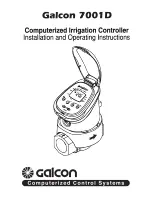
1 2 |
P a g e
Step 4:
Reinstall the filter cartridge into the filter housing and flush the chlorine solution by
opening all taps until chlorine can no longer be detected. Your home has now been completely
disinfected with your CalUltra UV system ready to inactivate any microorganisms that enter the
home.
Cleaning the Quartz Sleeve
Depending on the water quality, the quartz sleeve may require periodic cleaning. At a minimum,
the quartz sleeve should be cleaned on an annual basis. The following steps outline a basic
cleaning procedure.
Step 1:
If a by-pass assembly is installed, shut the inlet valve off to prevent water flow through
the system. Otherwise, turn off main water inlet valve (and/or turn off the water pump).
Step 2:
Disconnect power cord of UV system from electrical outlet.
Step 3:
Release water pressure by opening a downstream tap and then close the outlet shut-
off valve (if any). If there is no outlet shut-off valve, expect water to drain from the system as the
head pressure in the system will cause the water to flow back down.
Step 4:
Remove the captive ground screw from the ground lug on the UV unit.
Step 5:
Remove the lamp connector from the unit (gland nut) by pushing the lamp connector
in and turning it ¼ turn counter-clockwise. Disconnect the lamp connector from the lamp.
CAUTION: the lamp may be hot!
Step 6:
Being careful to touch only the ceramic ends, remove the lamp out of the unit.
Step 7
: Unscrew the gland nut from the unit exposing the end of the quartz sleeve.
Step 8:
Remove the quartz sleeve and o-ring by
gently twisting and pulling
the quartz sleeve.
Step 9
: Using a soft, lint-free cloth or towel wipe the sleeve down using a commercial scale
cleaner. This removes scaling or iron deposits that may be on the outside of the quartz sleeve.
Be careful not to get any moisture or liquids inside of the sleeve.
Step 10:
Dry the sleeve with separate cloth.
Step 11:
Replace the o-ring and slide the sleeve back into the reactor following steps 7 and 8
from the installation section of the manual.
Cleaning the UV Sensor (if applicable)
Depending on the water quality, the UV sensor may require periodic cleaning. At a minimum,
the UV sensor should be cleaning on an annual basis. The following steps outline a basic clean
-
ing procedure.













































